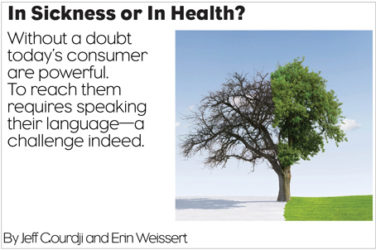It’s already enough of a problem that, as patients, our time with prescribers is limited to the legendary Warholian 15 minutes. Now, as marketers, we have to contend with an even more restrictive time frame: 15 seconds.
That’s the latest estimate1 of how much time people spend on average with an email based on a survey of millions of messages. And consider that, if you have any graphics in your message—even a logo—eyeballs will be skipping around to the images before they even read the text. That is, if the images even downloaded.
It’s tempting to blame this on the digital age, the fragmentation of focus that comes with our multiple-screen environment. Or the Millennials, whom we love to castigate as distracted multi-taskers. The study noted above covered users of all ages, however, and still came out with a minuscule average attention span.
Other factors are also at work here, mostly having to do with basic human nature. Have you ever sent a personal email to a colleague with more than one question or item in it? Have you noticed that frequently only the first item is addressed in the response? Rarely does the second get answered. Never the third.
That’s just the world we live in. We’re now exposed to about 360 ad messages2 a day, and can note only about half of those (hard to imagine that even that many are possible to focus on). And only a small fraction of that half is ever fully understood or acted upon.
What all this is pointing to is that we are obligated to observe an even stricter discipline today in the content, priority, length and user-friendliness of our messages if we even want to get someone’s attention, much less deliver information or make a sale. It comes down to this: Many of our communications are going to reach people who didn’t specifically ask for them and are scanning multiple messages. If this is the first impression you’re making on that person, it has to be spectacularly effective.
So here are a few factors that are vital to keep in mind when we re-read our promotional material before pushing “Send.” All of these apply to communication aimed at physicians, pharmacists and patients.
Content. As noted above about emails, your intent should not be to deliver a lot of information, but to keep it down to the bare essentials. If those resonate with your audience, you can give them the opportunity to seek out further information with a click or a tap.
Priority. Look at all the elements that your message contains. What is the first one you want people to see, the one that connects best with their concerns, pain points or needs? That’s the one you want to be most prominent in placement and in size.
Length. Even after you’ve edited down to the most relevant information, have you messaged in a compelling way? We don’t always need to use full sentences. This isn’t a college essay. A brief phrase like, “Most effective at treating Millennial malaise,” is a lot more compelling than, “In a double-blind study conducted with 1,032 patients over a six-month period, it was shown that…” and so on. Make your point first: Support it with the details later. Yes, you will have to re-educate your MLR teams about what your audience needs.
User-friendliness. Think about your own scanning of email. Which do you pay attention to first? Those that are most personal, usually from someone you know. As marketers, we don’t have the luxury of personally knowing all the people who are receiving our messages, and no one is fooled by something that starts out, “This is for you, Larry!”—but we can be respectful of their time and their ability to focus.
Clean Design. Too many graphics, too many font sizes, all trying to grab our attention at once, just fight with each other. What the digitally focused young people have taught us is that, in this new world, old-style advertising often loses.
Don’t Sell Too Hard. In fact, the less it looks like advertising, and the more it looks like information, the more likely it is to be read. Even George Lois, the granddaddy of effective advertising (“I want my MTV”), recently said, “Nowadays, the conventional wisdom is that you shouldn’t look like you’re selling. Never let them hear you ask for the sale. Because, the theory goes, young people are so aware of what’s going on, so sharp, that when you are hustling them, they feel it.” Remember, the prescribers may be younger than you nowadays!
Make ‘em Smile. The one addendum to this rule is that people and prescribers do tend to respond to humor, but that’s a very tricky thing to pull off, especially in an industry that caters to people’s health. Tread very lightly—maybe even consider taking the safe way out (Seinfeld fans pay attention)—make a little fun of yourself. (“We know that the drug label is REALLY long, but our R&D guys are proud of Melavin, and wanted you to know as much as they do.”)
It all comes down to this: Speak to your audience the way you want to be spoken to. If it looks like the ad you ignored or deleted the other day then it’s not the message you want to send out.
References:
1. “Alarming Research Results: Average Email Open Time is 15-20 Seconds – Recommendations for Emailers.” Accessed September, 2015. https://www.marketingsherpa.com/article/average-email-open-time-is.
2. “New Research Sheds Light on Daily Ad Exposures.” Accessed September, 2015. http://sjinsights.net/2014/09/29/new-research-sheds-light-on-daily-ad-exposures.



